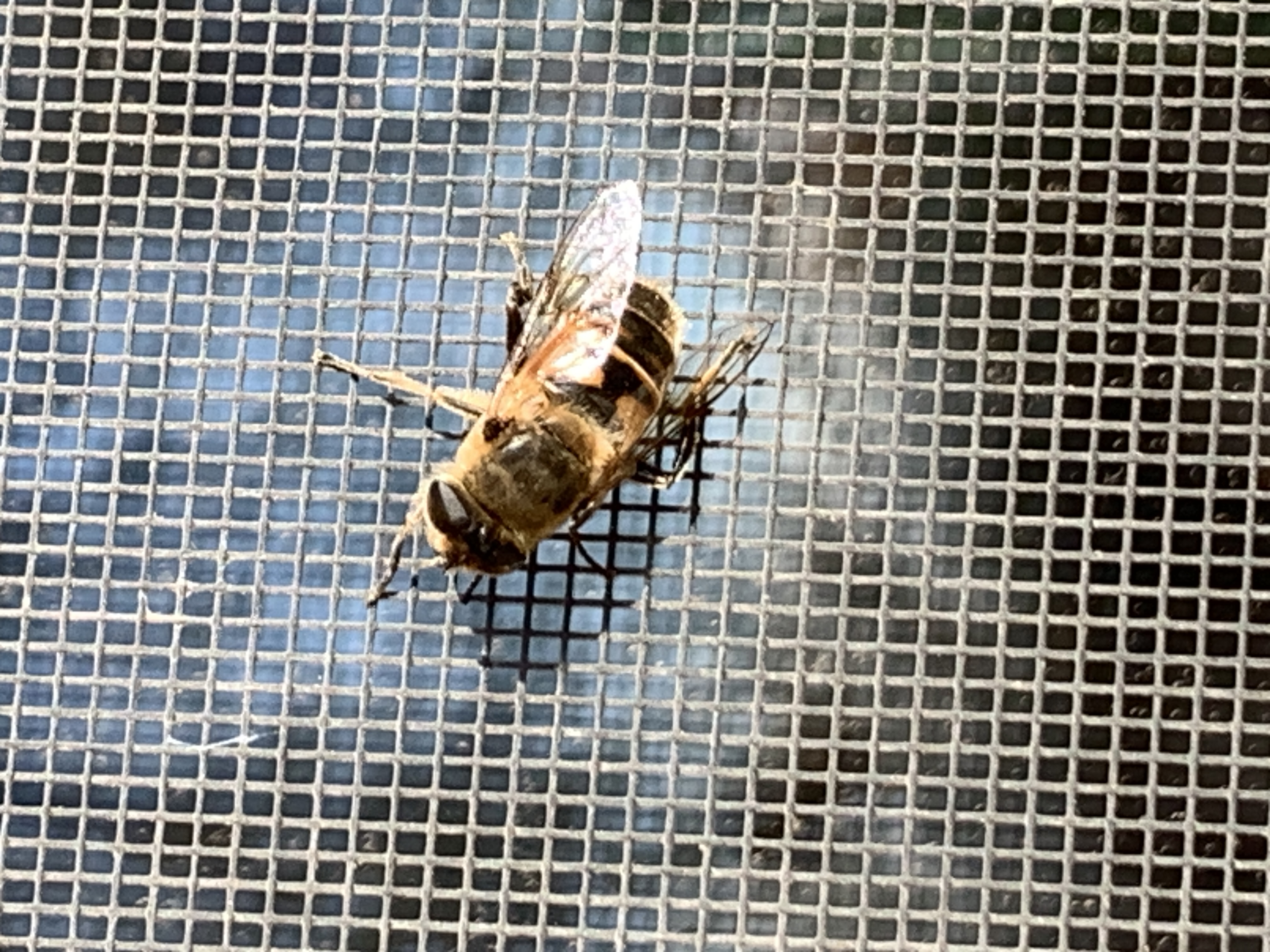On a late fall day, another type of insect clings to the screen. It reminds us of a bee with its fuzzy black and yellow stripes, but it has two translucent, membranous wings instead of four and bristles sticking out of its antennae. Also, unlike a bee, this critter has no waist and no stinger. It’s a common drone fly (Eristalis tenax), a member of the syrphid family of flies. Syrphid flies, also known as flower flies or hover flies, are major pollinators. They like yellow flowers such as daisies, asters and chrysanthemums, none of which are in season just now.
Last summer, in a behavior known as hill-topping, this female drone fly flew to the highest place she could find, and there she met her match. If they were feeling spunky, the couple mated while they were flying, with him on top of her. If they were feeling more sedate, they rested on a leaf. Either way, they fulfilled their imperative. Then they waved goodbye and went off to find more flowers to pollinate.
When the weather started to change, with daylengths shortening, and temperatures dropping, she began to look for a safe place to spend the winter. Cracks and crevices in our outbuildings, or underneath leaf piles make good options. Our window screen isn’t sufficient, but she may have designs on breaching the screen to shelter in the windowsill.
When she finds the right place, she will hunker down for the winter. Once she’s settled in, she will drop into a hibernation-like state called diapause. Her eggs will stop developing, and she’ll go into a kind of torpor where metabolic processes slow down. In the spring, she’ll come out of this state, finish developing her eggs and lay them somewhere close to a food source for the larvae. Meanwhile, her partner’s job is done by fall, and he does not survive the winter.
Drone flies undergo complete metamorphosis during their lifetime. Therefore, when the eggs hatch in early summer, little maggots emerge. They need to live in water, so their mother has chosen a shallow pond, a sewage lagoon, a ditch or drain as their first home. They prefer water with lots of decaying material in it.
The larvae are called rat-tail maggots because they have a straw of sorts at the back end that sticks up to break the surface of the water. It works like a snorkel, allowing the larvae to breathe. They eat detritus and decaying plant material while they snorkel along. After they’ve molted three times, it’s time to pupate and transform themselves into adult hover flies. As adults, their interest in dirty water gives way to a diet of nectar. What a switch!
Flies don’t chew. They actually eat a liquid diet only. In the case of the adult drone fly, that liquid is nectar. They also don’t suck the way we think of sucking. Instead, they use a tongue-like organ (a proboscis), to “lick” or dab at the liquid food. On the underside of the tongue a series of grooves sponge up the liquid and channel it through the food canal to the esophagus. They use capillary action to do this rather than active sucking. Capillary action, you may recall, is like wicking. Trees raise their sap that way, and flies ingest their liquid food using the same laws of physics—or is that chemistry?
The common drone fly is so named because it closely mimics the European honeybee (Apis mellifera). It looks like a honeybee, and it flies like a honeybee. Neither the drone fly nor the honeybee is native to the Americas. The common drone fly originated in Europe and Asia, and migrated to North America some time before 1874. They are now found in almost every one of the lower 48 states. It looks so much like a bee that it is often mis-identified and used as a portrait of the bee. That’s one place where its mimicking coloration doesn’t help much. On the other hand, birds don’t always know the difference either, and the resemblance to a honeybee saves the drone flies from being eaten more often than not.
So the larvae help clean up polluted water, and the adults spend their summers pollinating flowers. They don’t bite and they don’t sting. What’s not to like?
Photo by Author. Alt text: Another insect on the screen on the south side of the house on a cool fall day. It looks like a honeybee (a drone honeybee at that), but is a Common Drone Fly. It has a rotund body with circling tan bands, hair all over, large compound eyes covering most of its head. As a fly, it has only one pair of membranous flight wings, unlike the bee’s two pairs.

4 comments
What a great example of mimicry! Really interesting post 🙂
Interesting! I had no idea…
Damn if it doesn’t look like a bee. The eyes are the give-away. Glad they’re out there pitching in and not getting eaten by birds.
They all seem to diapause in the cracks of my kitchen window, Karen. Thank you for this piece!